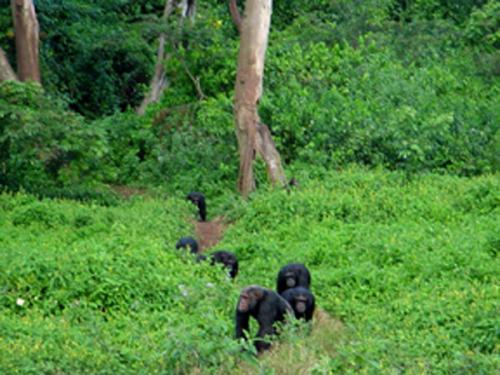[google-translator]
An excited whoop erupts from deep in the forest, boosted immediately by a dozen other voices, rising in volume and tempo and pitch to a frenzied shrieking crescendo. It is the famous ‘pant-hoot’ call: a bonding ritual that allows the participants to identify each other through their individual vocal stylisations. To the human listener, walking through the ancient forests of Gombe Stream, this spine-chilling outburst is also an indicator of imminent visual contact with man’s closest genetic relative: the chimpanzee.
Gombe is the smallest of Tanzania’s national parks: a fragile strip of chimpanzee habitat straddling the steep slopes and river valleys that hem in the sandy northern shore of Lake Tanganyika. Its chimpanzees – habituated to human visitors – were made famous by the pioneering work of Jane Goodall, who in 1960 founded a behavioural research program that now stands as the longest-running study of its kind in the world. The matriarch Fifi, the last surviving member of the original community, only three-years old when Goodall first set foot in Gombe, is still regularly seen by visitors.
Chimpanzees share about 98% of their genes with humans, and no scientific expertise is required to distinguish between the individual repertoires of pants, hoots and screams that define the celebrities, the powerbrokers, and the supporting characters. Perhaps you will see a flicker of understanding when you look into a chimp’s eyes, assessing you in return – a look of apparent recognition across the narrowest of species barriers.
The most visible of Gombe’s other mammals are also primates. A troop of beachcomber olive baboons, under study since the 1960s, is exceptionally habituated, while red-tailed and red colobus monkeys – the latter regularly hunted by chimps – stick to the forest canopy.
The park’s 200-odd bird species range from the iconic fish eagle to the jewel-like Peter’s twinspots that hop tamely around the visitors’ centre.
After dusk, a dazzling night sky is complemented by the lanterns of hundreds of small wooden boats, bobbing on the lake like a sprawling city.
About Gombe Stream National Park
Size: 52 sq km (20 sq miles), Tanzania’s smallest park.
Location: 16 km (10 miles) north of Kigoma on the shore of Lake Tanganyika in western Tanzania.
Getting there
Kigoma is connected to Dar and Arusha by scheduled flights, to Dar and Mwanza by a slow rail service, to Mwanza, Dar and Mbeya by rough dirt roads, and to Mpulungu in Zambia by a weekly ferry.
From Kigoma, local lake-taxis take up to three hours to reach Gombe, or motorboats can be chartered, taking less than one hour.
What to do
Chimpanzee trekking; hiking, swimming and snorkelling;
visit the site of Henry Stanley’s famous “Dr Livingstone I presume” at Ujiji near Kigoma, and watch the renowned dhow builders at work. .
When to go
The chimps don’t roam as far in the wet season (February-June, November-mid December) so may be easier to find;
better picture opportunities in the dry (July-October and late December).
Accommodation
1 new luxury tented lodge, as well a self-catering hostel, guest house and campsites on the lakeshore.
This is the end of our “”
Thank you for your interest to our programs. We hope that you will use the form below to book your safari with Travel Closer
Note: We can customize this program to carter your budget and safari expectations
PRICING TERMS
Price Includes:
|
Price Excludes:
|

